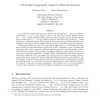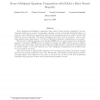11 search results - page 2 / 3 » How Many Oblivious Transfers Are Needed for Secure Multipart... |
ASIACRYPT
2008
Springer
13 years 8 months ago
2008
Springer
In an oblivious transfer (OT) protocol, a Sender with messages M1, . . . , MN and a Receiver with indices 1, . . . , k [1, N] interact in such a way that at the end the Receiver ...
ASIACRYPT
2007
Springer
14 years 5 days ago
2007
Springer
An extended abstract of this paper appears in Kaoru Kurosawa (Ed.): Advances in Cryptology ASIACRYPT 2007, volume 4833 of Lecture Notes in Computer Science, pages 265–282, Spring...
FSTTCS
2009
Springer
14 years 17 days ago
2009
Springer
ABSTRACT. A non-local box is an abstract device into which Alice and Bob input bits x and y respectively and receive outputs a and b respectively, where a, b are uniformly distribu...
FOCS
2006
IEEE
14 years 1 days ago
2006
IEEE
Secret sharing and multiparty computation (also called “secure function evaluation”) are fundamental primitives in modern cryptography, allowing a group of mutually distrustfu...
PKC
2010
Springer
13 years 10 months ago
2010
Springer
In many practical settings, participants are willing to deviate from the protocol only if they remain undetected. Aumann and Lindell introduced a concept of covert adversaries to f...


